夏のあらし!/Natsu no Arashi Review
Summer Storm
 Natsu no Arashi is the latest anime adaptation from manga-ka KOBAYASHI Jin, creator of the popular School Rumble series. Since the anime is produced by SHAFT, we have a classic example of how SHAFT can make things outrageously funny at times and mind numbingly idiotic at others.
Natsu no Arashi is the latest anime adaptation from manga-ka KOBAYASHI Jin, creator of the popular School Rumble series. Since the anime is produced by SHAFT, we have a classic example of how SHAFT can make things outrageously funny at times and mind numbingly idiotic at others.
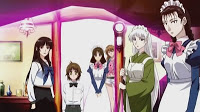 The story centers around young junior high school student Hajime and a summer he spends working at a cafe called the Ark — one of the few places to survive from World War II. Working with him is the ghost Arashi, who was apparently killed during an air raid in 1945 but every summer she somehow has physical form. She forms a mystical connection with Hajime which allows the two to travel back in time, where Arashi is keen on saving people, especially those from World War II.
The story centers around young junior high school student Hajime and a summer he spends working at a cafe called the Ark — one of the few places to survive from World War II. Working with him is the ghost Arashi, who was apparently killed during an air raid in 1945 but every summer she somehow has physical form. She forms a mystical connection with Hajime which allows the two to travel back in time, where Arashi is keen on saving people, especially those from World War II.
 Others in the cast are Jun — a girl Hajime’s age who pretends to be a boy; Kaja — another ghost from 1945 who was a German transfer student and friend of Arashi; Master — a con woman who somehow acquired the Ark and conned all of her employees into working for her; Hideo — a detective initially tasked with getting Arashi; Kanako — a girl with an agenda and vendetta; and Yayoi — a girl who experienced a huge trauma in her life that she has to recover from.
Others in the cast are Jun — a girl Hajime’s age who pretends to be a boy; Kaja — another ghost from 1945 who was a German transfer student and friend of Arashi; Master — a con woman who somehow acquired the Ark and conned all of her employees into working for her; Hideo — a detective initially tasked with getting Arashi; Kanako — a girl with an agenda and vendetta; and Yayoi — a girl who experienced a huge trauma in her life that she has to recover from.
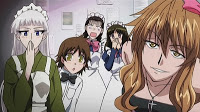 SHAFT decides to get things started by skipping to where all characters are already introduced . If you haven’t read the manga, a lot of the interactions, characters, and story thus far which are implied mean nothing to us. Then, they go back and decide to introduce the characters properly as they enter the overall story. While the first episode is funny, SHAFT presenting it first basically kills any sense of drama for most of the rest of the series because we already know where everyone will end up — at the Ark.
SHAFT decides to get things started by skipping to where all characters are already introduced . If you haven’t read the manga, a lot of the interactions, characters, and story thus far which are implied mean nothing to us. Then, they go back and decide to introduce the characters properly as they enter the overall story. While the first episode is funny, SHAFT presenting it first basically kills any sense of drama for most of the rest of the series because we already know where everyone will end up — at the Ark.
 There are two types of stories in this anime. The first are the serious stories where time trips to 1945 Japan are taken. I found these to be very impactful for the most part. SHAFT managed to give me the sense of what is must have been like to be caught in an air raid. I’ve watched many World War II movies and documentaries but in none of them did I get the feeling of fear that must be being experienced by those on the receiving end of the bombs. So I give props to SHAFT for pulling this off.
There are two types of stories in this anime. The first are the serious stories where time trips to 1945 Japan are taken. I found these to be very impactful for the most part. SHAFT managed to give me the sense of what is must have been like to be caught in an air raid. I’ve watched many World War II movies and documentaries but in none of them did I get the feeling of fear that must be being experienced by those on the receiving end of the bombs. So I give props to SHAFT for pulling this off.
 The only minor negative thing I have against the trips back to World War II is that there is a slight anti-American feel to them. The strongest comes from the incident where a lone American fighter targets a girl in a wheelchair for strafing. The other comes from the actual bombing of the city. I don’t know if any of this is in the manga or not, but the anime gives the feeling that the Americans shouldn’t have been bombing the crap out of
The only minor negative thing I have against the trips back to World War II is that there is a slight anti-American feel to them. The strongest comes from the incident where a lone American fighter targets a girl in a wheelchair for strafing. The other comes from the actual bombing of the city. I don’t know if any of this is in the manga or not, but the anime gives the feeling that the Americans shouldn’t have been bombing the crap out of  Japan. If that is what SHAFT is saying, I would remind them that Japan attacked the U.S. first. After that, the only way to wage war is to completely defeat your enemy, which is what we eventually did to Japan. After Japan was defeated, we Americans did what we are great at — helping the less fortunate. Now Japan is a close ally of the U.S. and Japanese comic arts are embraced by the U.S.
Japan. If that is what SHAFT is saying, I would remind them that Japan attacked the U.S. first. After that, the only way to wage war is to completely defeat your enemy, which is what we eventually did to Japan. After Japan was defeated, we Americans did what we are great at — helping the less fortunate. Now Japan is a close ally of the U.S. and Japanese comic arts are embraced by the U.S.
 Now that the serious stuff is out of the way, the rest (and majority) of the manga is devoted to comedy. Here, SHAFT hits both extremes by creating one of the funniest anime episodes I’ve watched (episode 8) where Jun and Hajime body-swap. However, they also create some of the biggest comedy bombs imaginable. Further, they run
Now that the serious stuff is out of the way, the rest (and majority) of the manga is devoted to comedy. Here, SHAFT hits both extremes by creating one of the funniest anime episodes I’ve watched (episode 8) where Jun and Hajime body-swap. However, they also create some of the biggest comedy bombs imaginable. Further, they run 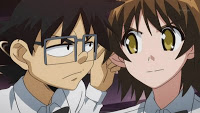 some jokes into the ground and then keep going until they pass through the Earth’s core and emerge on the other side. The first one is the salt joke where the same customer episode after episode asks for salt and never gets it. The other is the endless “I’ve read a book” jokes which describe some manga or anime series. Better have some deep anime and manga knowledge because otherwise you aren’t going to get the joke.
some jokes into the ground and then keep going until they pass through the Earth’s core and emerge on the other side. The first one is the salt joke where the same customer episode after episode asks for salt and never gets it. The other is the endless “I’ve read a book” jokes which describe some manga or anime series. Better have some deep anime and manga knowledge because otherwise you aren’t going to get the joke.
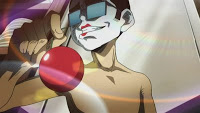 SHAFT also attempts to cram episodes full of parodies. I’m a fan of parody stuff even if I don’t get it. However, the production team at SHAFT seemed to think that there’s no such thing as too many parody references. It starts with the entire OP sequence, where SHAFT has parodies of countless Japanese album covers. This then continues with customers at the Ark, which are actually from other anime or manga titles. Food and beverage packages can have characters from Motsu (Negima!?) to Eri and Tenma from School Rumble. Frankly, this is parody overload and for me, it becomes tedious.
SHAFT also attempts to cram episodes full of parodies. I’m a fan of parody stuff even if I don’t get it. However, the production team at SHAFT seemed to think that there’s no such thing as too many parody references. It starts with the entire OP sequence, where SHAFT has parodies of countless Japanese album covers. This then continues with customers at the Ark, which are actually from other anime or manga titles. Food and beverage packages can have characters from Motsu (Negima!?) to Eri and Tenma from School Rumble. Frankly, this is parody overload and for me, it becomes tedious.
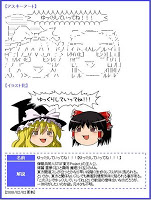 Episodes 1 and 13 have one of those bizarre heads on the weather vane. That’s one of the stranger things to come out of Japan. Apparently, two characters from a series of Touhou games (KIRISAME Marisa and HAKUREI Reimu) were drawn on a 2ch forum using SHIFT-JIS/ASCII art. The Japanese person doing this art only did the heads of the two characters and they came out with that dopey look with the inane grin. The characters were made to say, “Yukkuri Shite Ittene” which roughly means “take your time” or “take it easy.” As these things go, they took a life of their own and there’s all sorts of merchandise sold with these two heads on them. ^_^; SHAFT, being one to go with these kinds of things, used them twice for this series. Now you know. ^_^
Episodes 1 and 13 have one of those bizarre heads on the weather vane. That’s one of the stranger things to come out of Japan. Apparently, two characters from a series of Touhou games (KIRISAME Marisa and HAKUREI Reimu) were drawn on a 2ch forum using SHIFT-JIS/ASCII art. The Japanese person doing this art only did the heads of the two characters and they came out with that dopey look with the inane grin. The characters were made to say, “Yukkuri Shite Ittene” which roughly means “take your time” or “take it easy.” As these things go, they took a life of their own and there’s all sorts of merchandise sold with these two heads on them. ^_^; SHAFT, being one to go with these kinds of things, used them twice for this series. Now you know. ^_^
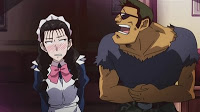 Should this anime ever be licensed in the U.S., I’m hoping that the R1 licensor will take the time to have an extra feature to point out all of the parody references and explain them. If the Japanese provide the notes to explain all this, it shouldn’t bee that big a project for the American company to do.
Should this anime ever be licensed in the U.S., I’m hoping that the R1 licensor will take the time to have an extra feature to point out all of the parody references and explain them. If the Japanese provide the notes to explain all this, it shouldn’t bee that big a project for the American company to do.
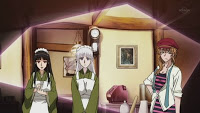 SHAFT also does things very stylized in their presentation of the anime. This really didn’t annoy me, but it often stuck out to me and was distracting. As such, I didn’t like it. The one time where this stylized approach worked well was when Jun experienced being in an air raid and the stylized presentation helped represent the terror she felt.
SHAFT also does things very stylized in their presentation of the anime. This really didn’t annoy me, but it often stuck out to me and was distracting. As such, I didn’t like it. The one time where this stylized approach worked well was when Jun experienced being in an air raid and the stylized presentation helped represent the terror she felt.
In the end, this is a typical SHAFT production that runs all over the place, both in highs and lows. The likable characters, mostly good humor, and interesting looks at World War II Japan outweigh the bad jokes, over stylized presentation, and the excessive parody references. Because I could rewatch the series, I’d buy it were it licensed in the U.S.



 July 15th, 2009
July 15th, 2009  AstroNerdBoy
AstroNerdBoy 

 Posted in
Posted in  Tags:
Tags: 
So far as “anti-American” goes, I never got that feeling. I mean, frankly, whichever side you’re on, war sucks, and whichever side you’re on, people do bad things in war, and whatever justification you make in terms of tactics, strategy, self-defense, or “they bombed us first,” that don’t stop the fact that you’re killing thousands of civilians who weren’t involved on the war front. And yes, we Americans were basically targeting Japanese civilians by the end of the war. And it wasn’t those civilians who decided to bomb Pearl Harbor.
Rather than Natsu no Arashi coming off as anti-American, instead your post feels somewhat too nationalistic.
Actually, civilians were very much part of the war effort. The town that Arashi and company come from had a factory that made war equipment. As such, you not only bomb the factory, you kill the workers who can repair that factory or who could be sent to other places to continue the war effort.
Having done a lot of research on WWII, the mindset then was that you killed the enemy. Anyone helping with the war effort on your opponent’s side was fair game. It sucks but that’s how we won the war (in part).
Anyway, that was only a minor issue on my part about the anime. ^_^
Wait, are you saying that a Japanese anime needs to “give the feeling” that the Americans should have been bombing the crap out of Japan, or you’ll call it “anti-American”? That’s not a very reasonable expectation. As a fellow American currently residing abroad, I find it annoying when some of my compatriots throw loaded words like “anti-American” left and right at the slightest provocation. I’ve never understood why. We have a great nation and shouldn’t be so touchy and easily offended.
Nope — I’m not saying that at all. As I mentioned, this anime did a good job of catching the horrors of war in a way that no other title has really done for me (that I’ve seen).
The lone fighter going out and just targeting Yayoi is what irritated me. If that scene hadn’t have happened, I wouldn’t have said much if anything on the whole anti-American subject. As it is, American fighters didn’t just go off on their own looking for people in wheelchairs to kill. Instead, that fighter would have been targeting the factory and the people around it, not trolling the hills outside of town. And it wouldn’t have been alone either because that’s just begging to get shot down.
I think this is a series that definitely comes off as a mixed bag but because we are getting a second season lets see if the writers can improved the shows strengths and tweak its flaws (hey, that more or less happened to Urusei Yatsura…)
Which reminds me, I need to watch more of UY. ^_^;
@Astronerdboy: Hence the plug
“The only minor negative thing I have against the trips back to World War II is that there is a slight anti-American feel to them.”
If anything the author of the original story would be the one putting messages in the plot, not SHAFT. But to be honest, no country anywhere should be (as you put it “bombing the crap out of” CIVILIAN CITIES.
“If that is what SHAFT is saying, I would remind them that Japan attacked the U.S. first.”
Hawaii wasn’t truly “American” in 1941. Look it up, Hawaii wasn’t made an American state until August 21, 1959 – quite some time after WWII ended. So technically you are wrong here, but more to the point, Pearl Harbour is a MILITARY FACILITY.
“After that, the only way to wage war is to completely defeat your enemy, which is what we eventually did to Japan.”
On the contrary, what America did was massacre millions of innocent people at the flick of a switch. This was not, war, it’s cold blooded murder. War is one system fighting another, soldiers fighting soldiers. It’s messy, and it’s wasteful, and a lot of the time it’s pointless, but there’s a huge difference between war and murder.
“After Japan was defeated, we Americans did what we are great at — helping the less fortunate.”
There’s so much wrong with this statement, I nearly died laughing. I think you’ve wasted enough of Earth’s oxygen supply, please stop breathing.
In adaptations, production companies change a lot, and SHAFT did change a lot from what I understand.
And yet, that’s how war was fought until very recent times. Before there was carpet bombing, cities where razed and countrysides plundered. Oh, and Japan was doing that in World War II — Ying-Tan, China, for example.
OK, now you’ve just gone off the deepend. Hawaii wasn’t a state, and I didn’t say it was. Hawaii WAS a an organized incorporated territory of the United States, meaning it was part of the official United States. So nice try, but maybe you should get your facts in order. 🙂
Yep, America did slaughter millions of civilians, but then the Japanese ordered their own citizens to commit suicide in Okinawa, and encouraged it by saying that the Americans would rape all the women and girls if they took the island.
On Saipan, the American were trying to save civilians by taking them prisoner to get them out of harm’s way. This resulted in Japan telling the Japanese on the island to commit suicide because the emperor did not want the Japanese fighting spirit harmed by civilians being taken care of by the Americans (and thus a positive propaganda tool).
Since the Japanese had shown they would fight to the last man and never surrender (I think the last Japanese holdout surrendered in the late 70s after being given official surrender orders from japan), and they had shown that they’d either kill their civilians, encourage their civilians to commit suicide (Banzai Cliff), or they’d force civilians to pick up arms, including school boys, America decided that they’d end the war in a way that didn’t cause any more allied deaths. Two nukes, and Japan surrendered.
Oh, and I know you’ll LOVE this, but America made conscious decisions to NOT bomb historical places like Kyoto.
Yeah, ’cause after the war, America didn’t rebuild Europe and protect them with our military from the Soviet threat. Oh wait, we did and still are protecting Europe through our alliance, if they should need it.
Also after the war, we didn’t rebuild and protect Japan. Oh wait, we did that too, and we are still helping defend Japan. Damn. Two for two. But hey, if your beliefs help you sleep at night, well who am I to stop you.
Ah, progressive tolerance and love on display there. Tell you what, why don’t you lead by example and stop breathing first. Then after you’ve been buried, I’ll consider taking you up on your offer. 😉